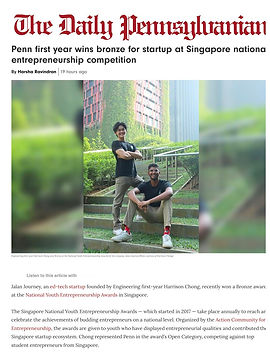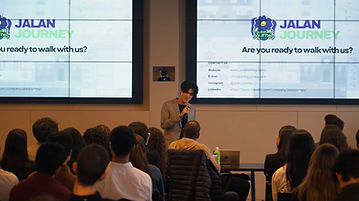Building Empathy, Igniting Change:
Explore the Power of Immersive Learning
Empowering character education in Singapore's schools through cutting-edge virtual experiential learning journeys.
Jalan Journey, an innovative edutainment game platform, emerges as a transformative solution championing character education in Singapore. Developed by our team, this groundbreaking platform harnesses the power of gamification to engage technologically adept youths in immersive learning experiences centered around sensitive social issues.
Project overview+ Results
the Goal
The goal was to create an immersive and engaging gamified platform that effectively addresses character education challenges in Singapore's schools.
My role
As the Wayfinding Designer, my focus was on crafting intuitive user journeys and designing interaction touchpoints within the game. I worked closely with the team to ensure seamless navigation, engaging storytelling, and clear communication of game mechanics and choices.
Results
April 2024, Jalan Journey clinched the Frederick H. Gloeckner Undergraduate Award, awarded to the highest-ranking undergraduate team at the Venture Lab Startup Challenge!
January 2024, Jalan Journey was awarded Bronze in the National Youth Entrepreneurship Awards Singapore!
As a founding member of Jalan Journey, I played a pivotal role in securing funding and laying the foundation for the project's vision. While my involvement concluded before the platform achieved a remarkable 95% success rate in schools, I take pride in my contributions to its early development and the role I played in setting the stage for its subsequent accomplishments, and wish the team all the best.



Challenge
Revolutionizing Character Education through Gamified Experiential Learning
Traditional character education methods were failing to effectively engage technologically adept youths. There was a need to find a solution that could provide interactive and immersive experiences to enhance character education, leveraging the power of gamification. The challenge was to create a platform that could effectively convey sensitive social issues while engaging students in a meaningful way.
Strategy
Creating Immersive Experiences and Meaningful Interactions
We developed Jalan Journey, an innovative edutainment game platform that immerses students in a free-roam digital world, allowing them to interact with the topic of homelessness. Through compelling narratives, decision-making, and moral choices, we aimed to foster empathy, critical thinking, and social responsibility. Our strategy focused on designing a safe and secured virtual space that provided students with a firsthand perspective of the challenges faced by marginalized individuals.
Outcome
Enhanced Engagement and Positive Character Development
Implementing user-centered design principles, conducting usability testing, and gathering feedback from teachers and students resulted in a remarkable 92.4% success rate among students. Jalan Journey successfully surpassed traditional character education methods by providing an immersive and captivating learning experience.
Revolutionizing Character Education through Gamified Experiential Learning
The challenges
In an increasingly digital age, traditional character education lessons often struggle to engage technologically adept youths. Recognizing this challenge, Jalan Journey, an edutainment game platform, emerged as a powerful solution. By leveraging gamified virtual experiences, Jalan Journey aims to bring students closer to sensitive social issues, particularly homelessness in Singapore, fostering engagement and promoting character education. This comprehensive UX case study explores the design considerations, detailed examples, efficacy measurements, and potential fixes to maximize learning and engagement within the game.
challenge 1
Tailoring Content and User Interactions
challenge 2
Wayfinding and navigation
challenge 3
Authenticity and Limitations of Personas
Challenge 1
Tailoring Content and User Interactions:
Limited choices and lack of depth in decision-making may hinder the game's ability to effectively convey the challenges faced by homeless individuals. Players may engage with Ah Beng, a gangster character, during a critical point in the game. The available response options might be limited to basic interactions, such as either appeasing or confronting Ah Beng. This limitation fails to capture the complexity of the situation and hinders players' understanding of the social dynamics surrounding homelessness.
fix 1
Expand the range of dialogue options and actions available to players when interacting with Ah Beng. Incorporate branching narratives or adaptive dialogue systems to provide a personalized and immersive experience. For instance, players could have the option to negotiate with Ah Beng to protect the community or seek alternative solutions that address the underlying issues of poverty and inequality.
limited choices
fix 2
Introduce consequences that reflect real-world outcomes and encourage players to consider the long-term effects of their choices. For example, the game could simulate the ripple effects of the player's decisions, such as the impact on the community's perception of the homeless or the character's own safety and well-being. Incorporate feedback mechanisms or reflection prompts to guide players in understanding the consequences of their actions and fostering empathy.
lack of depth & decision-making
Challenge 2
How to solve issues in Wayfinding and Navigation?
Players may struggle to locate key locations related to homelessness, such as the social office or areas where the homeless seek shelter. Without clear visual cues or intuitive map systems, players might become frustrated or disoriented, affecting their overall engagement with the game.
-
Implement clear and intuitive visual indicators, such as icons or markers, to guide players towards important points of interest. For instance, the social office could be represented by a distinctive symbol or highlighted in a specific color to make it easily identifiable on the map.
-
Incorporate visual cues within the game world itself, such as signboards or landmarks, that draw players' attention to significant locations related to homelessness.
inadequate visual cues
fix 1
unclear map systems
-
Improve the clarity and usability of the map system by providing clear labels, color-coding, and zoom functionalities. Enhance the map interface with tooltips or tutorial prompts to familiarize players with its features and functionality.
-
Design a mini-map or compass to provide ongoing orientation assistance, ensuring players can navigate the game world seamlessly.
fix 2
Challenge 3
Authenticity and Limitations of Game Personas:
Depicting the experience of a homeless individual through a game persona may lack authenticity and fail to fully capture the complexities of homelessness. To immerse players in the homeless persona's journey, specific touchpoints are incorporated into the game. For instance, the persona might face a challenging situation where they are caught sleeping on the street by a social worker, accompanied by their primary school son. The emotional and psychological impact of such experiences can be difficult to portray authentically in a game.
-
Collaborate with social workers, homeless individuals, or organizations working in the field to gather firsthand accounts and insights.
-
Engage individuals who have experienced homelessness to share their stories, emotions, and challenges.
-
Incorporate real-life narratives or testimonials into the game to provide a more authentic representation of the homeless experience.
By involving those directly affected, our game can not only serve the marginalized by accurately representing their stories, it also allows for greater depth of empathy and understanding among players.
lack of authenticity
fix 1
-
Supplement the game with additional educational resources, such as discussion guides or classroom activities, to provide context and facilitate deeper conversations about homelessness.
-
Use reflective prompts within the game to encourage players to consider the complexities and nuances of homelessness beyond the limited scope of the game mechanics.
This approach ensures that the game serves as a starting point for broader discussions and helps students grasp the multifaceted nature of social issues.



